Lowell Walks: Virtual Tour of Acre
In response to the public health-related postponement of yesterday’s Lowell Walk on the Irish Acre, here is a virtual tour of a portion of that neighborhood. The text is based on the script I used to lead this tour in April 2016. The tour Dave McKean would have given yesterday would have visited other locations, so when it is eventually rescheduled, please join us. In the meantime, here’s a view of some interesting spots in the Acre neighborhood:

North Common Amphitheater
North Common History – Purchased by the city from the Proprietors of Locks and Canals in 1845. Approximately 10 acres including the Morrow School which was on Adams Street. The North Common was originally a passive park but tennis and basketball courts and baseball field erected in 1970s. Morrow School was demolished in 1970. The Charlotte Murkland elementary school constructed in early 1990s. About 500 students, PK to 5. Amphitheater originally from 1970s for concerts. Overgrown and in disrepair. In 2011-12, rehabbed by ACTION, city of Lowell, other groups.
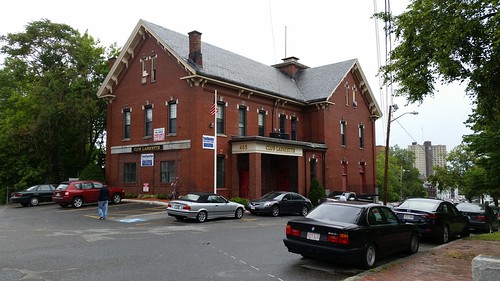
Club Lafayette – In 1913 a group of prominent Franco-American citizens of Lowell assembled and discussed the anomaly of Franco-Americans celebrating Le Jour de l’An in clubs not French, where the members did not have the same ties of language, blood, and tradition surging through their veins. They decided to form a high-grade French club under the name of Club Lafayette, named after that great Frenchman, the apostle of American liberty, who is the greatest Franco-American. On December 4, 1913 the Club Lafayette was incorporated. There were 97 charter members, men well-known in the community life of Lowell, and especially in Franco-American centers. The club was first located at 831 Merrimack Street, and the grand opening was held with a very successful New Year’s Eve Party held December 31, 1913. The club operated at this location for six years and then moved in 1920 to 59 Wannalancit Street, in what was then known as the Stone Castle and the Bowers Castle, where remained until January 31, 1924. It then became the opinion of the majority of the members that it was not centrally located and not within reach. The location was again changed to 663 Merrimack Street at the corner of Cabot Street, occupying the three upper floors of that building where it remained until April 23, 1939. The club then purchased the Fletcher Street Fire House at 465 Fletcher Street and completely renovated it into modern club rooms.
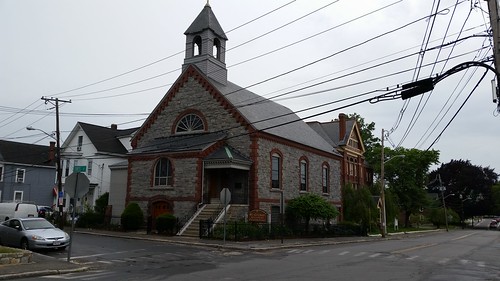
St George Antiochian Orthodox Church – built in 1883 by French Protestants. Sold in early 1917 to some Syrian-Lebanese families who had come to Lowell in the mid-1880s. It was dedicated as a church in 1919.
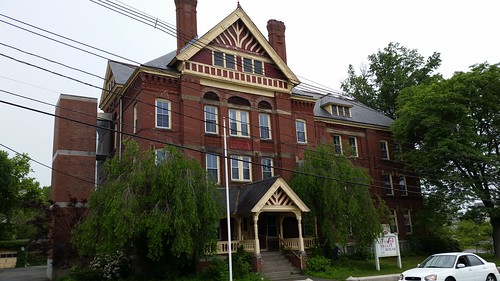
Old Ladies Home

(I’m not being mean; that’s what the sign says)
Old Ladies Home – 520 Fletcher St – built in 1882 as a home “for the purpose of supporting aged and feeble women” It could accommodate 35 women who turned over all of their possessions in exchange for lifetime support and care.

O’Donnell Funeral Home – established in 1884 in Lowell, Massachusetts and at 130 years, is the oldest family owned and operated Funeral Home in Greater Lowell. Now, the fourth generation of the O’Donnell family operates it.

Brian Kinney Monument – Kinney died on September 11, 2001. Here is his entry in the New York Times “Portraits of Grief” which featured each of the victims of the 9/11 terrorist attacks. As a child, Brian Kinney pumped gas at his family’s Texaco station in Lowell, Mass,. But even after college, when he put on a suit and started to work at PricewaterhouseCoopers in Boston, he spent Saturdays in his greasy old clothes, working alongside his dad. Mr. Kinney was grateful to his father for putting him through school, and he also loved catching up with customers’ news. That was Mr. Kinney; equally comfortable in a white collar or a blue one; tireless in his capacity for work; a friendly, enthusiastic fellow who asked “How are you?” before “Fill it up?” because he really wanted to know. Decades earlier, Alison Hardy’s father had worked at Kinney’s. When she was 14, her father said she could cash her paychecks there. Brian wasn’t yet allowed to handle money, but his father made an exception for Alison, so Brian had an excuse to talk with her when she came by. They married in 1998, settled in Lowell, visited their families weekly, planned to start their own. At 28, the engaging, industrious Mr. Kinney had risen from intern to manager at Pricewaterhouse. He could have taken care of that California client by phone. But on Sept. 11, Mr. Kinney boarded United Airlines Flight 175 because he wanted to shake the client’s hand and see how he was really doing.
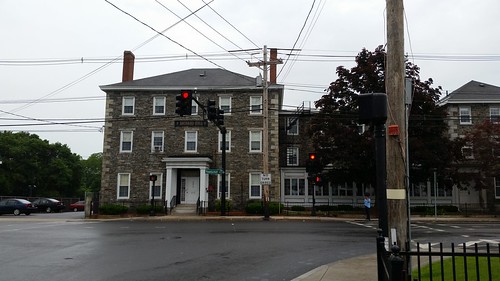
Stone House – 267 Pawtucket St. Constructed in 1824 as a tavern and hotel by Phineas Whiting. Samuel Coburn was the first innkeeper. March 1, 1826, citizens of new town gathered at the Old Stone House to establish a government for the new town. Sold to Locks and Canals which used it as a private guest house. David Crocket was entertained here during his visit to Lowell. In 1854, James C. Ayer purchased the house for $7000. He died in 1878. His wife, Josephine, in 1892, sold the house to the Home for Young Women and Children for $1. In 1964, it was sold to St Joseph’s Hospital as a residence for nuns, known as Bachand Hall. Most recently operated by nuns as a foster home for young women.
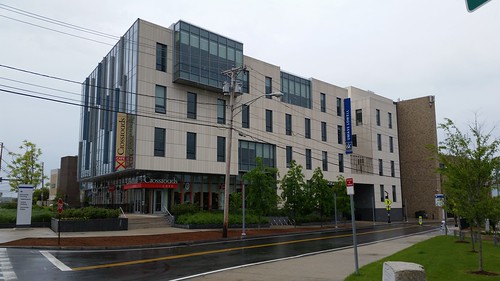
UMass Lowell’s University Crossing on site of St. Joseph’s Hospital
St Joseph’s Hospital – Founded as Lowell Corporation Hospital in 1839, transferred to Archdiocese of Boston in 1930 and became St. Joseph’s Hospital. In 1992, St. Joseph’s and St. John’s Hospitals merged to form Saints Memorial Medical Center. The St. Joseph’s “campus” fell into disuse after that. In 2011, UMass Lowell announced it was purchasing St. Joseph’s for $6.3mil for a new campus center. In 2012, demolition of most of St Joseph’s Hospital commenced to be replaced by UMass Lowell University Crossing. Also in 2012, Saints merged with Lowell General Hospital.
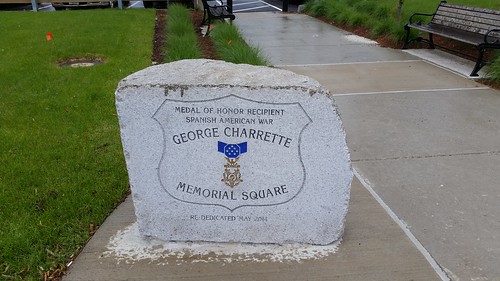
George Charrette (Medal of Honor) Square – In June 1898, George Charrette was a gunner’s mate on the USS New York, the flagship of the US Navy squadron under the command of Rear Admiral William T. Sampson that was hunting the Spanish Caribbean Fleet. Seeking to avoid battle with the more powerful American navy, the Spaniards fled to Santiago Harbor, a large port with only a narrow opening to the sea that was protected by numerous forts and gun emplacements. Unable to draw the Spanish fleet out to sea, Sampson devised a bold plan that would send a stripped down US ship into the narrow harbor channel where it would be scuttled by its volunteer crew, thereby closing the channel and trapping the Spanish fleet in the harbor. To command this hazardous mission, Admiral Sampson selected a young officer named Richmond Pearson Hobson and gave him command of the USS Merrimac, a steam powered cargo ship built in Norway in 1894 and purchased by the Navy in April 1898. Despite the difference in spelling, this ship was named for the river that passes through the city of Lowell. Hobson planned to sail the Merrimac into the channel in the dark of night, turn it sharply to one side and simultaneously ignite what he called “torpedoes” that be placed along the side of the ship beneath its waterline. These torpedoes were more like massive pipe bombs; 18-inch wide metal canisters filled with gunpowder that would be ignited by electricity, a novel and not completely reliable detonation technique in 1898. In response to a request for eight volunteers for this mission, nearly every sailor in the fleet stepped forward. For the critical task of detonating the explosives, Hobson chose Charrette who had extensive experience with gun powder and who had previously served with Hobson on another ship. On the appointed night, Hobson, Charrette and their seven comrades donned life jackets and pistols and set out for the harbor on what many considered a suicide mission. As they raced into the harbor channel at full speed, the Spanish fortress gunners spotted the Merrimac and poured sustained and heavy fire into the ship. As the Merrimac approached the narrowest part of the channel, Hobson shut down the engines and ordered the helmsman to turn sharply to starboard. While the wheel on the bridge turned, the rudder did not: it had been shot away as had most of the torpedoes. Only two exploded and the resulting holes in the side of the ship were too small to instantly sink the ship. With the anchor shot away, there was no way to halt forward momentum and the Merrimac slid to the side of the channel, finally settling on the bottom clear of the main shipping path. Amazingly, all nine Americans aboard not only survived, but had escaped all injury. They plunged into the water and were rescued the next morning by Spanish soldiers. Out of respect for their demonstrated bravery, the crew was well treated by their Spanish captors and just a few days later were turned over to the advancing American Army. For their heroism, George Charrette and the eight others who sailed the Merrimac into Santiago Harbor that night were awarded the Medal of Honor. While still imprisoned in Cuba, Charrette was promoted to Gunner (a Warrant Officer rank). For the rest of his Navy career, he alternated shipboard assignments with time ashore, mostly at the Charlestown Navy Yard. He was promoted to Lieutenant in 1917 and retired in 1925 at age 58. He lived the rest of his life in Lowell, dying on May 7, 1938 at age 70. He is buried at Arlington National Cemetery.
 Wilfred Lavasseur (Whiting Street) Park – empty lot until 2012. Using surplus building materials from other renovations and projects, plus murals from the Revolving Museum, it has been remade as a community garden with help from Mill City Grows, CBA, Parks & Conservation Trust, UML, YouthBuild. Mr. Levasseur was founder of Cote’s Market.
Wilfred Lavasseur (Whiting Street) Park – empty lot until 2012. Using surplus building materials from other renovations and projects, plus murals from the Revolving Museum, it has been remade as a community garden with help from Mill City Grows, CBA, Parks & Conservation Trust, UML, YouthBuild. Mr. Levasseur was founder of Cote’s Market.
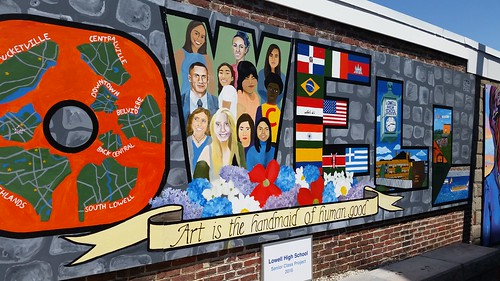
Decatur Way – dedicated in 2016. Another community partnership incorporating art, environmentally sound building techniques.

Cote’s Market – Cote’s Market, was a fourth-generation family business (now under new ownership) that has occupied the same spot on Salem Street for almost 100 years, serves 300 pounds of their famous baked beans each week along with other French-Canadian specialties such as Chinese pie and pork scrap. Every Saturday morning, lines of people, most addressed by name, answer the query “with or without?” by stating their preference for beans with chunks of salt pork or without. Here, Roger Levasseur, whose grandfather Joseph Elphege Cote opened Cote’s Market in 1917, and Stephanie Quinones, offer a pint of beans and a pork pie, two of Cote’s most popular products.

site of deadly 1982 fire
Decatur Street Fire – March 5, 1982 at 1am. Five alarm fire at three story, 9 unit woodframe apartment building at 32-36 Decatur Street. Eight people died. Man convicted of murder and arson. Granted new trial in 2014 by Massachusetts Supreme Judicial Court.
 St Jean Baptiste Church – 1868, Fr. Andre Garin, OMI from France opened St Joseph’s Church on Lee St in a former Protestant temple. It was the first Franco-American parish in Archdiocese of Boston. 1887, Fr. Garin purchased “the Bonney House” at 725 Merrimack for use as rectory. In 1888, he laid the cornerstone for a church which was completed in 1896 right after his death. Statue unveiled same year. He also founded grammar school, high school. 1908 the parish founded the Franco American Orphanage at 357 Pawtucket St in the Ayer Mansion.
St Jean Baptiste Church – 1868, Fr. Andre Garin, OMI from France opened St Joseph’s Church on Lee St in a former Protestant temple. It was the first Franco-American parish in Archdiocese of Boston. 1887, Fr. Garin purchased “the Bonney House” at 725 Merrimack for use as rectory. In 1888, he laid the cornerstone for a church which was completed in 1896 right after his death. Statue unveiled same year. He also founded grammar school, high school. 1908 the parish founded the Franco American Orphanage at 357 Pawtucket St in the Ayer Mansion.
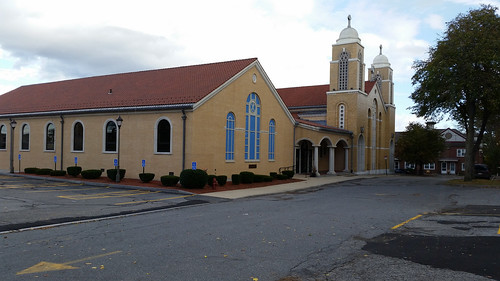
Transfiguration of Our Saviour Church History – The Transfiguration of Our Saviour Greek Orthodox Church was founded in 1924. Without a physical building to call their own, early parishioners first worshipped together at St. Anne’s Episcopal Church on Merrimack Street in Downtown Lowell and later in a second floor hall of a large building on the corner of John and Paige Streets. In 1925, under the leadership of Transfiguration’s first resident pastor, Father Panos Constantinides, the current site of the church was purchased. A temporary church was erected, and services took place in the basement for many years under the spiritual leadership of Father Demetrios Frangos, Father Christos Pappas and Father Polyefktos Phinfinis. In 1951, Father John Papadopoulos was installed as the church’s permanent pastor. In 1952, steps were taken to construct the church that we worship in today. Through the generosity of 200 families, all but the interior was completed by 1956. Father John Sarantos came to our community in the fall of 1956. He celebrated his first Divine Liturgy at the Transfiguration on November 5, 1956, and he led the Transfiguration family for thirty-seven years. During those years, the parish grew substantially, and the church interior was transformed. From 1959 through 1963, the interior of the church was furnished with pews, a bishop’s throne, and a chanter’s chair. Stained glass windows were installed throughout the church, and the iconostasis was constructed. The eastern wall of the sanctuary was adorned with the first mosaic icon. On October 18, 1964, the church was consecrated by Archbishop Iakovos. At turn of the century, the Transfiguration faithful voted to undertake a building expansion project. The Groundbreaking Ceremony for the Transfiguration Family Life Center took place on June 17, 2001, with Father Gregory and Father Nicholas Triantafilou, President of Hellenic College Holy Cross Greek Orthodox School of Theology, blessing the site. Along with a chapel, the new structure would come to house offices, meeting rooms for the church’s many ministries, and Sunday School classrooms. It also allowed the Transfiguration Church to become handicap accessible.
Look for another Virtual Lowell Walk next weekend and please visit richardhowe.com each day for new stories, articles, poems and updates.
Great stuff, Dick!
Thank you Dick!! Very good idea!
Thank you, Dick! We greatly appreciate the text. Even though we were with you on that tour, it’s impossible to remember all of the wonderful stories and details you give to us.
This was wonderful; thank you – very thoughtful and informative. What a very kind gesture ~
This is terrific! Can we make this a regular feature?
So many great walk in Lowell those of us in other parts of the country will never ne able to attend… Mill Girls Walk? Yes!!!! Literary Lowell? Yes !!!!
Thanks everyone. My hope is to post a new Virtual Lowell Walk each Sunday morning for the duration of the pandemic.
Love this, thank you!
I love walking around Lowell and to now know some of the stories behind the scenes is just awesome. And the timing impeccable ;)
Thank you, as always, for giving so much, Dick. As a born and raised Lowellian, I’m always surprised by how much I learn from you. The story of Brian Kinney was deeply moving. Perhaps especially relevant for me because I have a son who works at PriceWaterhouseCoopers, who also lost a friend Sean Nassaney on the same flight.
Enjoyed walk very much. Many memories of Lowell. Thank you. Ray Johnson, Chelmsford, Lowell tech. Santa Monica CA.
Lowell has so much history. Loved the tour. So many historical places that we have passed by so many times. A neighbor in N. Chelms
I very much enjoyed reading the Tour of the Acre looking forward to more Virtual Lowell Walks!
Lowell: always in my heart! Merci beaucoup, Richard.
It’s amazing how we pass by these buildings frequently and don’t take time to notice their beauty nor their history. If walls could talk. Thank you Dick for providing photos and commentary into these city treasures.
Loved this. Thank you!
Just one comment Looks like a typo in “Wilfred Lavasseur (Whiting Street) Park”. His last name we spelled with an “e” Levasseur.
Thank you, Dick!
What a wonderful tour. So many interesting historical facts and photos. I look forward to the walking tours again.